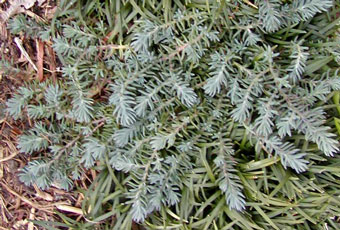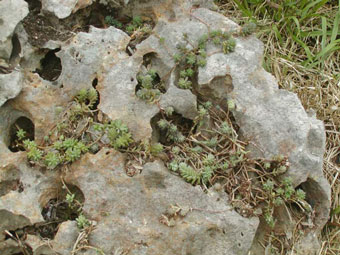Stonecrop Sedum
Sedum acre
. . . for a low growing touch of green in the most rugged sites
 |
Common names: Stonecrop Sedum, Wall ginger, Creeping Moss
Latin Name: Sedum acre
Design Tips: Use as a soil cover for potted topiaries, as a ground cover in shrubberies or rock gardens, or plant in the niches of stone walls. It can edge naturalized walkways in a creeping pattern, or drape over the edges of raised beds and sun-baked planters.
Form: This low-growing sedum spreads rapidly in cool weather by sending out roots from its succulent stems. Newly rooted offsets continue to multiply into a densely matted, heat-tolerant groundcover.
Size: In ideal conditions, the mat can grow from 2 to 6 inches tall.
Flowers: Umbels of tiny yellow stars appear on the terminals of 4 to 6 inch stems in spring, but only on well-established mature plants.
Foliage: The small fleshy leaves have the water and nutrient storage ability of a cactus. In the growing season, they are a blue-gray green, darkening purplish in cold snaps and are of the shape and size of cooked rice, whorled around the entire length of each stem.
Soil: The plant will tolerate the best soil, as well as the least excuse for dirt - even sand and alkaline caliche, through flood or drought, with good drainage.
Light Exposure: Best development occurs in full sun, but it will grow in part shade.
Hardiness: The roots are cold hardy in USDA Zones 3-9, and the foliage is winter evergreen in mild-winter climates.
Grooming: In a naturalized setting, the plants are perfectly happy to be left totally neglected. In formally groomed designs, the finished flower umbels can be snipped off for a tidier appearance. In densely planted beds, the plant spread may need confining or thinning away from other small plants or formal edgings.
Propagation: Sedums root easily from stem cuttings or detached stems, forming new plants quickly without assistance in moist conditions. In other words, throw some pieces on the ground in spring, and walk away.
Snippets: The name Stonecrop is casually applied to many of the 400 species in the sedum genus, growing wild around the world. It is so named for its ability to thrive in the tiniest amount of soil lodged in cracks of stone, even on the shear face of cliffs, as described by its Gaelic name which translates to "stone's pickaxe". My daughter once hot glued some rootless stems of Stonecrop into a shoebox vignette for a school project. When she brought it home, weeks later, it was still alive and growing tall and lanky as it reached for light, by living off its reserves in the fat little leaves.
 |
Return to Plant Profiles Index
Cultivated, photographed and written
by Maggie Ross McNeely in Fort Worth, Texas
All rights reserved